The sports movement has for many years received money to counteract the differences in sports among children and young people.
Despite that, new statistics show big differences in children's sports if you compare different residential areas.
- What is new is that the differences are now more clearly visible, says Johan Norberg who is a sports researcher at Malmö University.
"Sports cannot solve segregation"
The government is now expected to send even more money to the National Sports Confederation, to, among other things, "promote integration and crime prevention work".
But Johan Norberg is not convinced that this is the solution.
- Sports can be an actor that gives young people meaningful free time, but you cannot give sports the task of solving segregation.
The sports associations must join forces with other actors such as municipalities and schools.
And different solutions are needed in different areas.
"No associations that can receive contributions"
If you only increase the general support for the sports associations, it rather increases the differences.
- Such support will always bring more money to residential areas where sports are already very active.
In the really tough areas, there are often no sports associations.
And if you want to activate young people there, then perhaps the solution is not more money for sports.
Because there are no associations that can receive that money.
In the video, the sports researcher summarizes his conclusions from the new statistics.

